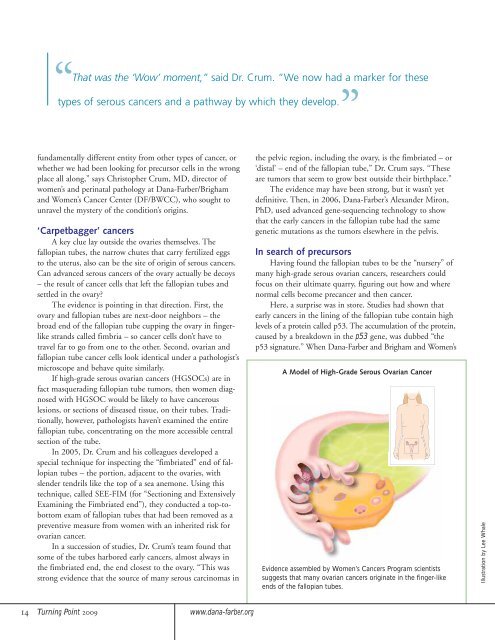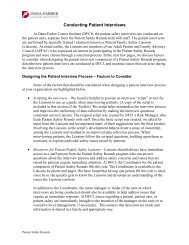Turning Point - Dana-Farber Cancer Institute
Turning Point - Dana-Farber Cancer Institute
Turning Point - Dana-Farber Cancer Institute
You also want an ePaper? Increase the reach of your titles
YUMPU automatically turns print PDFs into web optimized ePapers that Google loves.
“<br />
That was the ‘Wow’ moment,” said Dr. Crum. “We now had a marker for these<br />
”<br />
types of serous cancers and a pathway by which they develop.<br />
fundamentally different entity from other types of cancer, or<br />
whether we had been looking for precursor cells in the wrong<br />
place all along,” says Christopher Crum, MD, director of<br />
women’s and perinatal pathology at <strong>Dana</strong>-<strong>Farber</strong>/Brigham<br />
and Women’s <strong>Cancer</strong> Center (DF/BWCC), who sought to<br />
unravel the mystery of the condition’s origins.<br />
‘Carpetbagger’ cancers<br />
A key clue lay outside the ovaries themselves. The<br />
fallopian tubes, the narrow chutes that carry fertilized eggs<br />
to the uterus, also can be the site of origin of serous cancers.<br />
Can advanced serous cancers of the ovary actually be decoys<br />
– the result of cancer cells that left the fallopian tubes and<br />
settled in the ovary?<br />
The evidence is pointing in that direction. First, the<br />
ovary and fallopian tubes are next-door neighbors – the<br />
broad end of the fallopian tube cupping the ovary in fingerlike<br />
strands called fimbria – so cancer cells don’t have to<br />
travel far to go from one to the other. Second, ovarian and<br />
fallopian tube cancer cells look identical under a pathologist’s<br />
microscope and behave quite similarly.<br />
If high-grade serous ovarian cancers (HGSOCs) are in<br />
fact masquerading fallopian tube tumors, then women diagnosed<br />
with HGSOC would be likely to have cancerous<br />
lesions, or sections of diseased tissue, on their tubes. Traditionally,<br />
however, pathologists haven’t examined the entire<br />
fallopian tube, concentrating on the more accessible central<br />
section of the tube.<br />
In 2005, Dr. Crum and his colleagues developed a<br />
special technique for inspecting the “fimbriated” end of fallopian<br />
tubes – the portion, adjacent to the ovaries, with<br />
slender tendrils like the top of a sea anemone. Using this<br />
technique, called SEE-FIM (for “Sectioning and Extensively<br />
Examining the Fimbriated end”), they conducted a top-tobottom<br />
exam of fallopian tubes that had been removed as a<br />
preventive measure from women with an inherited risk for<br />
ovarian cancer.<br />
In a succession of studies, Dr. Crum’s team found that<br />
some of the tubes harbored early cancers, almost always in<br />
the fimbriated end, the end closest to the ovary. “This was<br />
strong evidence that the source of many serous carcinomas in<br />
the pelvic region, including the ovary, is the fimbriated – or<br />
‘distal’ – end of the fallopian tube,” Dr. Crum says. “These<br />
are tumors that seem to grow best outside their birthplace.”<br />
The evidence may have been strong, but it wasn’t yet<br />
definitive. Then, in 2006, <strong>Dana</strong>-<strong>Farber</strong>’s Alexander Miron,<br />
PhD, used advanced gene-sequencing technology to show<br />
that the early cancers in the fallopian tube had the same<br />
genetic mutations as the tumors elsewhere in the pelvis.<br />
In search of precursors<br />
Having found the fallopian tubes to be the “nursery” of<br />
many high-grade serous ovarian cancers, researchers could<br />
focus on their ultimate quarry, figuring out how and where<br />
normal cells become precancer and then cancer.<br />
Here, a surprise was in store. Studies had shown that<br />
early cancers in the lining of the fallopian tube contain high<br />
levels of a protein called p53. The accumulation of the protein,<br />
caused by a breakdown in the p53 gene, was dubbed “the<br />
p53 signature.” When <strong>Dana</strong>-<strong>Farber</strong> and Brigham and Women’s<br />
A Model of High-Grade Serous Ovarian <strong>Cancer</strong><br />
Evidence assembled by Women’s <strong>Cancer</strong>s Program scientists<br />
suggests that many ovarian cancers originate in the finger-like<br />
ends of the fallopian tubes.<br />
Illustration by Lee Whale<br />
14<br />
<strong>Turning</strong> <strong>Point</strong> 2009<br />
www.dana-farber.org

















